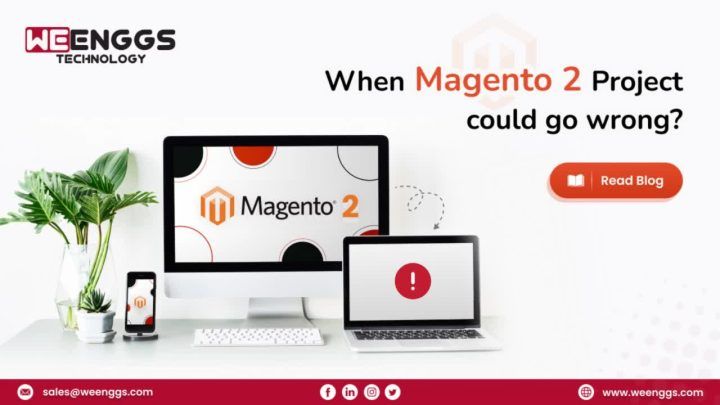Magento 2 is a powerful e-commerce platform that allows businesses to create feature-rich and scalable online stores. However, like any complex software project, Magento 2 implementations can encounter challenges that might impact the success of the project. In this blog, we will explore ten crucial points where a Magento 2 project could go wrong and provide practical strategies to mitigate these potential pitfalls.
1. Poor Project Planning and Scope Definition:
One of the primary reasons for project failure is inadequate planning and scope definition. When project goals, requirements, and timelines are not clearly defined, it becomes challenging to manage resources effectively, leading to delays and confusion.
→ Mitigation Strategy:
- Conduct a comprehensive project scoping phase with all stakeholders to gather and document specific requirements.
- Create a detailed project plan outlining milestones, deliverables, and responsibilities.
2. Lack of Technical Expertise:
Magento 2 development is a sophisticated platform that demands expertise in web development, PHP, and e-commerce best practices. Relying on an inexperienced or inadequately skilled development team can lead to implementation errors and suboptimal performance.
→ Mitigation Strategy:
- Hire experienced Magento 2 developers with a proven track record in e-commerce projects.
- Consider partnering with a reputable Magento development agency to ensure expertise and efficiency.
3. Inadequate Resource Allocation:
Insufficient allocation of resources, such as time, budget, and personnel, can severely impact the progress and success of a Magento 2 project.
→ Mitigation Strategy:
- Conduct a thorough resource assessment before commencing the project to ensure proper allocation.
- Monitor resource usage regularly to identify potential bottlenecks and address them promptly.
4. Scope Creep and Continuous Changes:
Frequent changes to project requirements and scope, commonly known as scope creep, can disrupt the development process, leading to increased costs and extended timelines.
→ Mitigation Strategy:
- Establish a robust change management process to evaluate and approve any scope changes.
- Clearly communicate the implications of scope changes to all stakeholders to avoid misunderstandings.
5. Inadequate Testing and Quality Assurance:
Insufficient testing and quality assurance can lead to undiscovered bugs, security vulnerabilities, and poor user experience, negatively impacting customer satisfaction.
→ Mitigation Strategy:
- Implement comprehensive testing, including functional, performance, and security testing, at each development stage.
- Conduct thorough user acceptance testing (UAT) to ensure the website meets the client’s expectations.
6. Performance and Scalability Issues:
A Magento 2 store must be able to handle heavy traffic and transactions without compromising performance. Failure to address performance and scalability concerns can result in slow loading times and frequent crashes during peak periods.
→ Mitigation Strategy:
- Conduct load testing to identify performance bottlenecks and optimize code and server configurations.
- Utilize caching mechanisms, content delivery networks (CDNs), and scalable hosting solutions to enhance performance.
7. Security Vulnerabilities:
Ignoring security best practices can expose the website to cyber-attacks and data breaches, leading to compromised customer information and reputational damage.
→ Mitigation Strategy:
- Regularly apply security patches and updates released by Magento.
- Implement SSL certificates and encryption to secure sensitive data and transactions.
8. Poor User Experience (UX):
A subpar user experience can drive potential customers away, resulting in decreased sales and diminished brand trust.
→ Mitigation Strategy:
- Prioritize user-centric design and conduct usability testing to optimize the website’s navigation and layout.
- Ensure mobile responsiveness for a seamless experience across all devices.
9. Inadequate Communication and Collaboration:
Effective communication and collaboration among project stakeholders are essential to maintain transparency and align expectations.
→ Mitigation Strategy:
- Establish regular meetings and reporting mechanisms to keep all parties informed about the project’s progress.
- Encourage open communication channels for prompt issue resolution.
10. Post-Launch Support and Maintenance Neglect:
Once the Magento 2 store is launched, neglecting post-launch support and maintenance can lead to unresolved issues and performance problems.
→ Mitigation Strategy:
- Offer post-launch support packages to address any issues promptly.
- Plan for regular maintenance activities, including updates and backups, to ensure the website’s optimal performance.
Conclusion:
A successful Magento 2 project requires careful planning, technical expertise, proper resource allocation, and vigilant testing and maintenance. By identifying these ten potential pitfalls and implementing the suggested mitigation strategies, businesses can navigate the complexities of Magento 2 development more effectively and achieve a successful and high-performing e-commerce store.
Weenggs Technology has an expert team of App Developers who can help you with the best and affordable solution for your business. Talk to us at sales@weenggs.com


